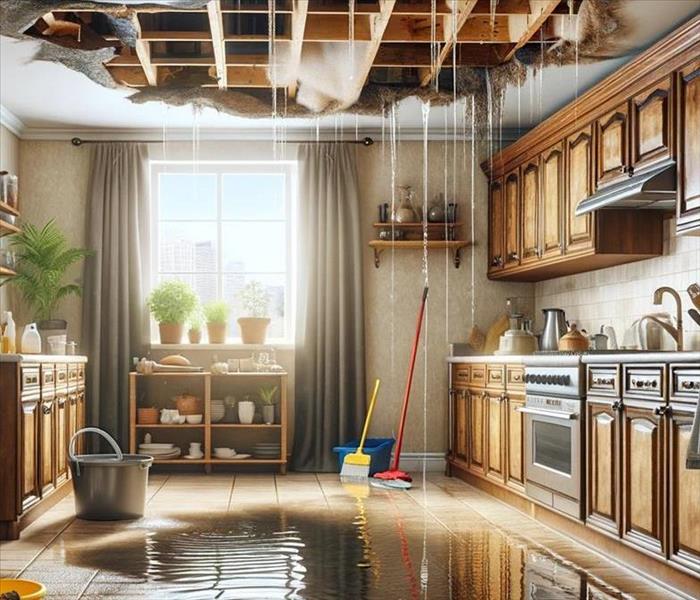Water Damage? We Can Help
3/18/2024 (Permalink)
Following a major leak, flood, or any water intrusion, the cleanup process extends far beyond merely mopping up puddles and allowing carpets to dry. Water damage restoration professionals are tasked with the critical responsibility of sanitizing contaminants, removing irreparable property, and restoring salvageable items. The Institute of Inspection, Cleaning and Restoration Certification (IICRC) categorizes water damage based on the source of water, distinguishing between clean water, gray water, and black water, each requiring different cleanup approaches.
Types of Water Damage
Clean water, originating from sanitary sources, poses minimal risk to individuals and typically results from incidents like rainwater or leaking supply lines. Gray water, containing contaminants that may cause discomfort or illness, includes sources such as showers or dishwashers. Black water, the most hazardous category, often stems from sewage or flooding and necessitates extensive sanitization.
Possible Solutions
Water damage restoration entails three primary stages: mitigation, remediation, and restoration. Mitigation involves halting the damage's progression by stopping the water flow, removing excess water, and drying affected areas. Remediation focuses on cleaning, deodorizing, and sanitizing salvageable materials, while also removing irreparable items. Restoration encompasses repairing and restoring the property to its pre-damaged state.
Mitigation or Remediation?
Mitigation and remediation steps include assessing the damage severity, removing damaged materials, extracting water, and implementing drying equipment. The aim is to contain the initial damage and prevent its escalation. Remediation involves thorough cleaning and disinfection, particularly in cases of black water damage. However, the distinction between mitigation and remediation can sometimes blur, as both processes overlap in certain scenarios.
Restoration efforts go beyond temporary fixes, involving permanent solutions such as repairing or replacing damaged structures and ensuring moisture levels are sufficiently low to prevent mold growth. While many personal items can be successfully cleaned post-flooding, certain structural elements may require replacement during the restoration process.
We do the Job Right
Amidst the challenges of water damage restoration, entrusting the task to skilled professionals equipped with advanced technologies can make all the difference. SERVPRO of East Cobb stands out as a beacon of expertise and innovation in the field of water restoration. With a team of highly skilled technicians and access to cutting-edge equipment, SERVPRO of East Cobb is committed to delivering efficient and effective solutions to mitigate and restore water-damaged properties. Utilizing state-of-the-art technologies, such as advanced drying equipment and moisture detection tools, they ensure thorough and precise restoration processes. By harnessing the power of innovation, SERVPRO of East Cobb strives to exceed expectations and provide unparalleled service to their clients in Marietta and the surrounding areas. When facing the aftermath of water damage, trust in the expertise of SERVPRO of East Cobb to restore your property with precision and care.
When repairing water damage, safety precautions are paramount. SERVPRO of East Cobb may do things such as shut off electricity, ensure thorough drying to prevent mold growth, and addressing damaged structural elements promptly. Repair methods include replacing damaged drywall, flooring, and siding, as well as installing waterproof materials to prevent future damage.
Tips for effective water damage repair include maintaining home humidity levels below 60% to inhibit mold growth and comparing replacement versus restoration costs for damaged items. Additionally, precautions should be taken when dealing with contaminated water, and photographic documentation of damage is advised for insurance purposes.
In conclusion, water damage restoration is a multifaceted process requiring meticulous attention to detail and adherence to safety protocols. By following proper procedures and seeking professional assistance when needed, individuals can effectively mitigate and repair water damage, restoring their properties to a safe and habitable condition.






 24/7 Emergency Service
24/7 Emergency Service